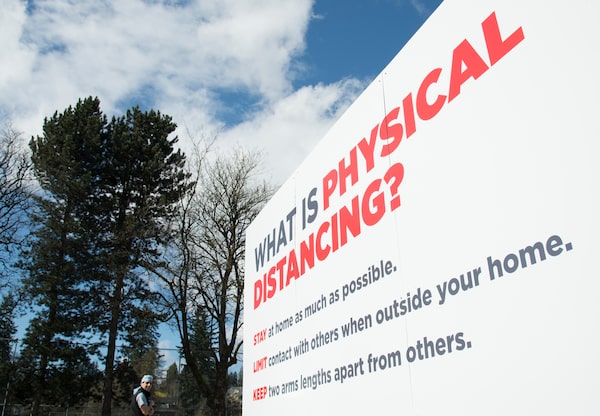
A man walks past a physical distancing sign at the Royal Columbian Hospital in New Westminster, B.C. on April 3, 2020. In another 10 to 14 days, we will have a much better sense of whether or not the much-desired flattening of the curve is happening.JONATHAN HAYWARD/The Canadian Press
The next two weeks are crucial.
That phrase is being repeated, time and time again – a mantra by politicians and public-health officials.
In another 10 to 14 days, we will have a much better sense of whether or not the much-desired flattening of the curve is happening.
Why?
In a couple of weeks, most travellers will have completed their mandatory period of self-isolation and we will know whether they have fallen ill with COVID-19.
What will be left is community transmission – people who have no recent travel history and don’t really know where they were infected.
In the past week, 80 per cent of new cases have been community-acquired. That’s both bad and good.
Bad because it tells us there are likely a lot more coronavirus cases than in the official data. Good because it means measures such as social distancing could have a real impact.
But it will take a bit of time to know the measures are working.
The coronavirus has an incubation period of up to 14 days, so today’s numbers are giving us a snapshot of what happened 10 to 14 days ago.
A lot has happened in that period, from the mandatory isolation of travellers to the closing of non-essential businesses.
Whether or not these are working will only become somewhat more clear in the not-too-distant future. Canada’s penchant for incrementalism doesn’t make it any easier to figure out.
When Italy locked down, it locked down. When states such as New York adopted shelter-in-place rules, the hammer came down.
In Canada, there has been a steady drip, drip, drip of new federal, provincial and municipal rules. It can be difficult to figure out what people can do, where, on any given day.
People are already getting antsy about the semi-lockdowns and stay-at-home suggestions. They are looking for some indication the sacrifices they are making are paying off.
Italian doctors’ fatalities reach tragic levels as they fight COVID-19 in overburdened hospitals
Trudeau warns U.S. over restricting the trade of essential goods into Canada
The data we have are not particularly comforting.
Two of the numbers epidemiologists look to for clues are the doubling rate and the tenfold rate.
Canada’s doubling rate is currently five days, i.e. we had 6,000 cases five days ago and now we have 12,000. That’s one of the worst in the world, identical to the United States.
By comparison, the doubling rates in Spain and Italy are seven days and 12 days respectively. They have far more cases than Canada, but their spread is slowing.
The tenfold rate – the number of days it takes for the number of cases to increase 10 times – is 13 days for Canada, i.e. we had 1,200 cases two weeks ago and now we have 12,000.
If we continue at this rate, in two weeks we will have 120,000 cases. That’s frightening but possible. (For comparative purposes, the tenfold rate is 16 days in Spain and 23 days in Italy.)
What Canada desperately needs is a deceleration in cases – a decrease in speed of the increase in numbers.
That’s not happening yet.
In fact, for the coming days we can expect sharp increases to continue, a surge. Again, that’s not all bad. You want to weed out all the cases as quickly as possible so you can isolate the infected, track down their contacts, and slow the spread.
At some point, the upward trajectory on the epidemic curve (something that almost everyone can now picture in their minds) will peak.
The problem is that we don’t know when we’ve reached the peak until it has passed. And only then can the curve start to flatten.
It’s worth remembering too that this doesn’t mean there will no longer be COVID-19 cases, just that they will increase more slowly.
This is really important to know if we want to keep hospitals from being overwhelmed as they have been in New York and some European countries.
In recent days we’ve seen a newfound mania for modelling – predicting how many cases, hospital intakes and intensive care admissions will occur.
What those models tell us is that we can expect either a trickle or a torrent of new cases this month.
How cruel April ends up being will depend largely on our ability to double down on public health measures – more vigorous testing, stopping chains of transmission in high-risk environments such as nursing homes and near-universal buy-in on continuing isolation and social distancing.
Letting down our guard now will only prolong the pain.
 André Picard
André Picard